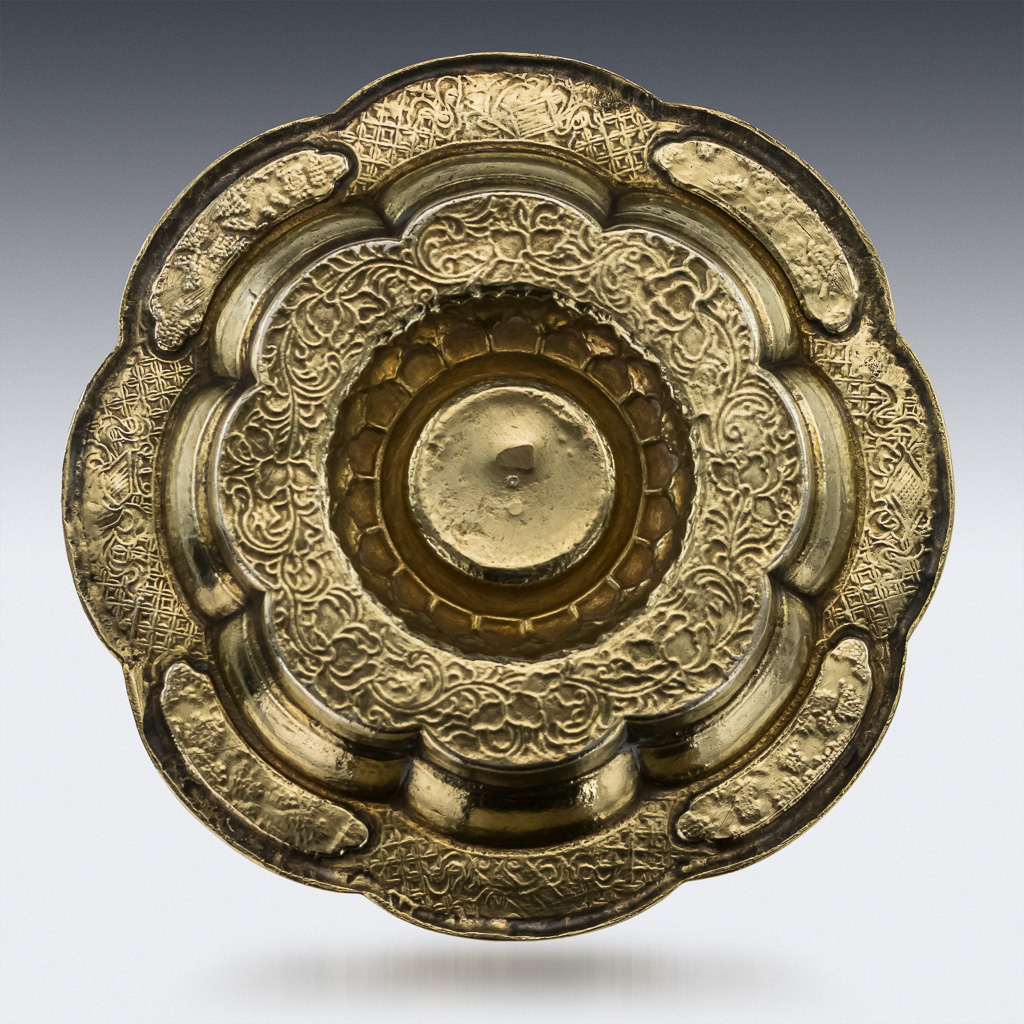ANTIQUE 18THC CHINESE QING DYNASTY SOLID SILVER-GILT TEA CUPS & SAUCERS C.1700
Early-18th Century Chinese Qing Dynasty silver-gilt pair of tea cups and saucers, repousse and fine chased work, cast cups dipicting people of nobility surrounded by blossom trees and pogodas on finelly tooled ground, mounted with unusually shaped cast scroll handles. The saucers beautifully hand engraved and each applied with four convext sections dipicting birds amongst blooming flowers, such recuring scenes were favourite of Chinese court and painters of the Ming Dynasty and would continue to be used in later Chinese works of Art.
REFERENCE NUMBER: A5284
DESCRIPTION
Antique early-18th Century Chinese Qing Dynasty solid silver-gilt pair of tea cups and saucers, Exeptionally hand crafted, repousse and fine chased work, cast cups dipicting people of nobility surrounded by blossom trees and pogodas on finelly tooled ground, mounted with unusually shaped cast scroll handles. The saucers beautifully hand engraved and each applied with four convext sections dipicting birds amongst blooming flowers, such recuring scenes were favourite of Chinese court and painters of the Ming Dynasty and would continue to be used in later Chinese works of Art.
It was the Portuguese and Dutch traders who first imported tea to Europe, with regular shipments by 1610, which would explain how this delightful pair ended up in Holland and bear the later import marks.
A Chinese Export Silver coffee pot made circa 1670 of similar style, is now in the Royal Collection in the UK and is to be found in Queen Victoria’s former private seaside residence on the Isle of Wight, Osborne House.
What makes this coffee pot particularly unique is that it was only in 1652 that the first coffee house in London was opened. As with almost all Chinese silver of this period, it does not carry a maker’s mark.
King Charles II married the Portuguese Catharine of Branganza in 1662. On coming to England she brought with her a casket of tea and quickly became known as the tea-drinking queen. She took to inviting her friends into her bed chamber to share tea with her. Tea was generally consumed within a lady’s closet or bedchamber and for a mainly female gathering and a tea “equipage” was at that time kept there too rather than in a kitchen or salon. Catharine was known to have favoured using a silver tea pot.
One of the earliest Chinese Export Silver tea pots dates to circa 1680 marked TA and with London hallmarks for 1682 within the collection of The Peabody Essex Museum, Massachusetts, USA.
It’s of globular hexagonal form on a conforming rim foot. The body has six shaped oval panels cast and chased with a scene, three symbolic of spring with a scholar on a horseback with servant behind in search of plum blossom, crossing a bridge within plum blossom, pine and bamboo with a bird above, all on matted ground, and three alternate panels almost identically cast but with pagoda to the left and fu dogs above, the hexagonal neck and spout cast and chased with birds on floral sprays, the flat chained cover with similar scene within plain hexagonal border and surmounted by a spherical finial with flower spray, the angular handle with later inserted ivory insulators. As with almost all Chinese silver of this period, it carries no maker’s mark; it weighs a very hefty 882g.
Saurcers hallmarked with Chinese character marks, Dutch Import marks ZII (835 standard, used 1953-present), When the Netherlands revised their hallmarks in 1953, a problem arose of what to do with finished goods, both domestic and foreign, that were already circulating in the trade. The Netherlands Assay Office sometimes referred to these items as used objects. As complete assaying procedures could damage a finished item, a new set of three Z marks was initiated for use on silver items that had undergone a limited assay.
For more information please see A. Von Ferscht, Chinese Export Silver 1785-1940, 4th edition 2015.
CONDITION
In Excellent Condition - No Damage.
SIZE
Height: 6cm
Width: 11cm
Combined Weight: 420g
























